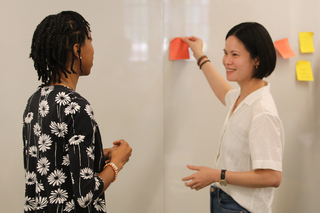Grants and fellowships don’t only fund your research—they also attest to your achievements and promise as a scholar in your field. When applying for a fellowship, understanding the goals of the funding agency and navigating the components of the application can be a daunting process. The GWL Fellows on our team have secured a wide range of competitive fellowships. You can draw on their experience through our workshops, peer-review groups, and one-on-one consultations as you navigate the application process. The resources below offer additional guidance on how to shape your proposal and submit a polished application.
Looking for Models?
Find annotated passages from NSF GRFP and NIH F31 applications on our Writing in Academic Genres page.
Finding Funding Opportunities
Ideally, you should cast a wide net with your applications. But preparing the fellowship and grant applications is time-consuming, so you should prioritize your target funding opportunities based on:
- The timing (your career stage)
- Your need (consider your funding needs one year ahead)
- Your odds of winning (typical success rates and your fit with the funding institution’s goals)
- Other personal and/or professional considerations, such as how this will affect your access to resources through the funding institution.
The best way to learn about relevant funding opportunities is through your professional networks—what funding opportunities do your advisor and peers know about, and what funding opportunities do major organizations in your field sponsor?
See our guide to Searching and Applying for Academic Funding to find ideas for funding sources and links to many individual funding opportunities for graduate study, including resources for international students and new American students.

Search for relevant funding opportunities:
- Yale Grants Database
- Sponsored Programs Information Network (SPIN) (login through Yale’s subscription)
- The MacMillan Center
Learn more about academic funding at Yale:
I learned a lot about what reviewers are looking for, and this improved the quality and impact of my application. I think without this group my application would be less refined specifically for what the reviewers are looking for.
Participant in an NIH F30/31 Peer-Review Group, 2023
Application Writing Tips
Know your audience! Are the reviewers for this fellowship/grant specialists or non-specialists in your research area? What do they care about? How will they be assessing you.
Aim to be clear and concise. Reviewers spend little time on each application, so be to-the-point. Examine the fellowship description for key phrases about the funding institution’s goals and talk to previous awardees about their recommendations, then tailor your application accordingly.
Writing a Research Proposal for Graduate Fellowships
Writing a Personal Statement for Graduate Fellowships
Get feedback on your application materials! Assemble a team of feedback-givers from within and outside your field, including your advisor(s) and, ideally, people who have previously received this fellowship or grant.
At the Graduate Writing Lab, you can get feedback on your writing from our Graduate Writing Fellows–experienced fellowship writers trained to give you writing feedback and support you in all your writing goals–in one-on-one consultations and in fellowship peer-review groups.
The NSF GRFP funds up to three years of doctoral or masters study across STEM fields, for students whose projects and careers have great potential to advance knowledge in their field as well as great potential to benefit society.
Check out our NSF GRFP guide to learn more about eligibility, review criteria, and our tips for writing the two essays in the application.
The GWL runs peer-review groups for NSF GRFP applicants every summer and fall. See our Peer-Review Groups page for more information, and reach out to the GWL’s Assistant Director of Scientific Communication, Lauren Gonzalez, if you would like to join a group.
The NIH’s NRSA F30 and 31 supports doctoral candidates in the biomedical sciences whose projects align with the mission of an NIH institute, focusing both on the merit of their research project and the strength of their training plan.
Check out our guides to these predoctoral NIH fellowships to learn more about eligibility, the timeline for preparing your application, a list of the application documents, and our tips for writing the Research Strategy.
- NIH NRSA F30/31 Quick Start Guide
- NIH NRSA 30/31 Essential Documents Checklist
- Tips for NIH NRSA F30/31 Research Strategy
- Repurposing Your F30/31 Documents for Application Changes (for resubmissions in 2025)
The GWL runs peer-review groups for NIH F30 & F31 applicants for most application cycles. See our Peer-Review Groups page for more information, and reach out to the GWL’s Assistant Director of Scientific Communication, Lauren Gonzalez, if you would like to join a group.
The DoD’s NDSEG program supports graduate students engaged in science and engineering research relevant to US national security (conceived broadly).
Check out our guide to the DoD NDSEG to learn more about eligibility, how applications are evaluated, and our tips for writing the research proposal.
Still Have Questions?
For additional information about fellowship writing support the Graduate Writing Lab offers, contact Lauren Gonzalez or email grad.writing@yale.edu.
Explore GWL Programs
-
Writing Consultations
Get 1-on-1 feedback at any stage of the writing process—from brainstorming to final edits.
-
Workshops & Panels
Interactive opportunities to grow your academic writing knowledge or expand your toolkit of skills.
-
Peer-Review Groups
Groups of 4–7 students who meet weekly to share feedback, make progress, and support one another on a common project.
-
Writing Retreats & All Writes
Full-day and half-day events where graduate students set goals and write as a community in a quiet, supportive space.
-
Audience
-
Category


